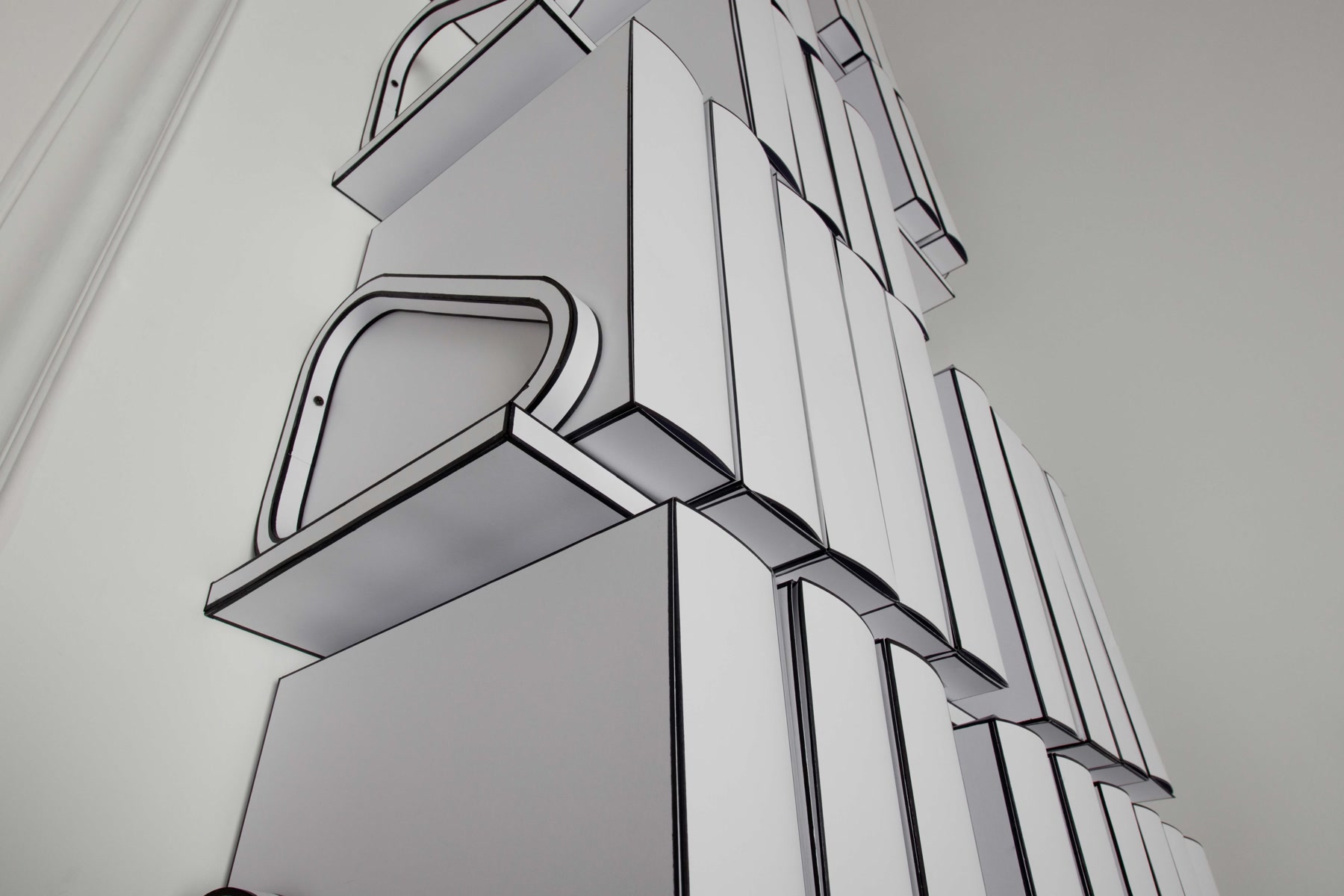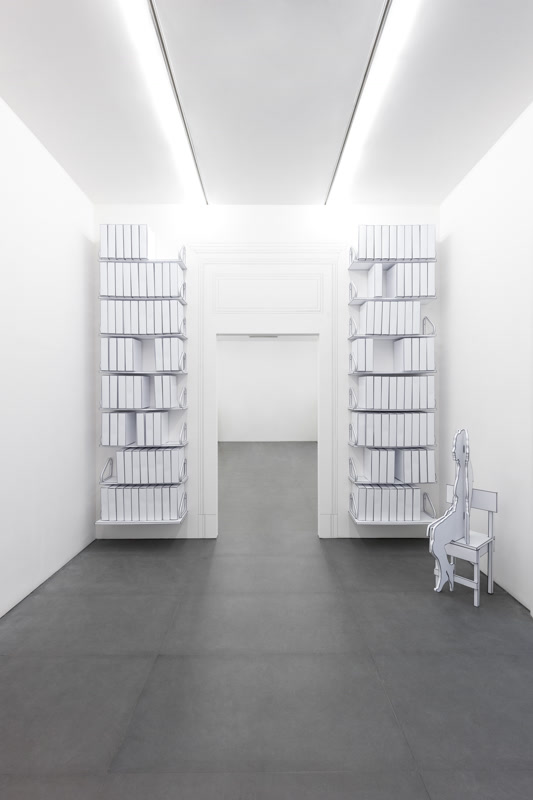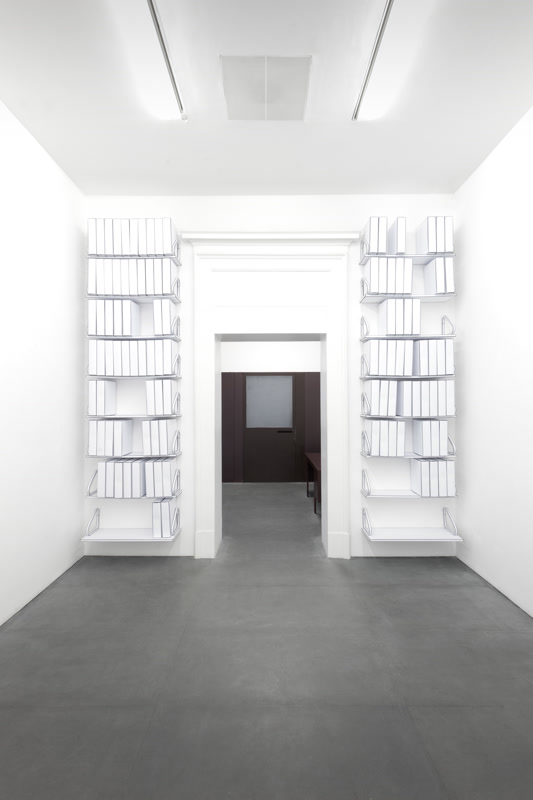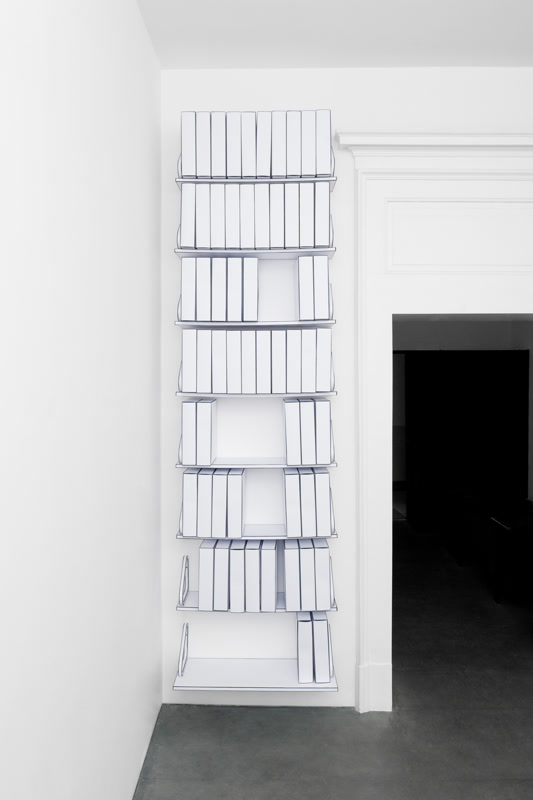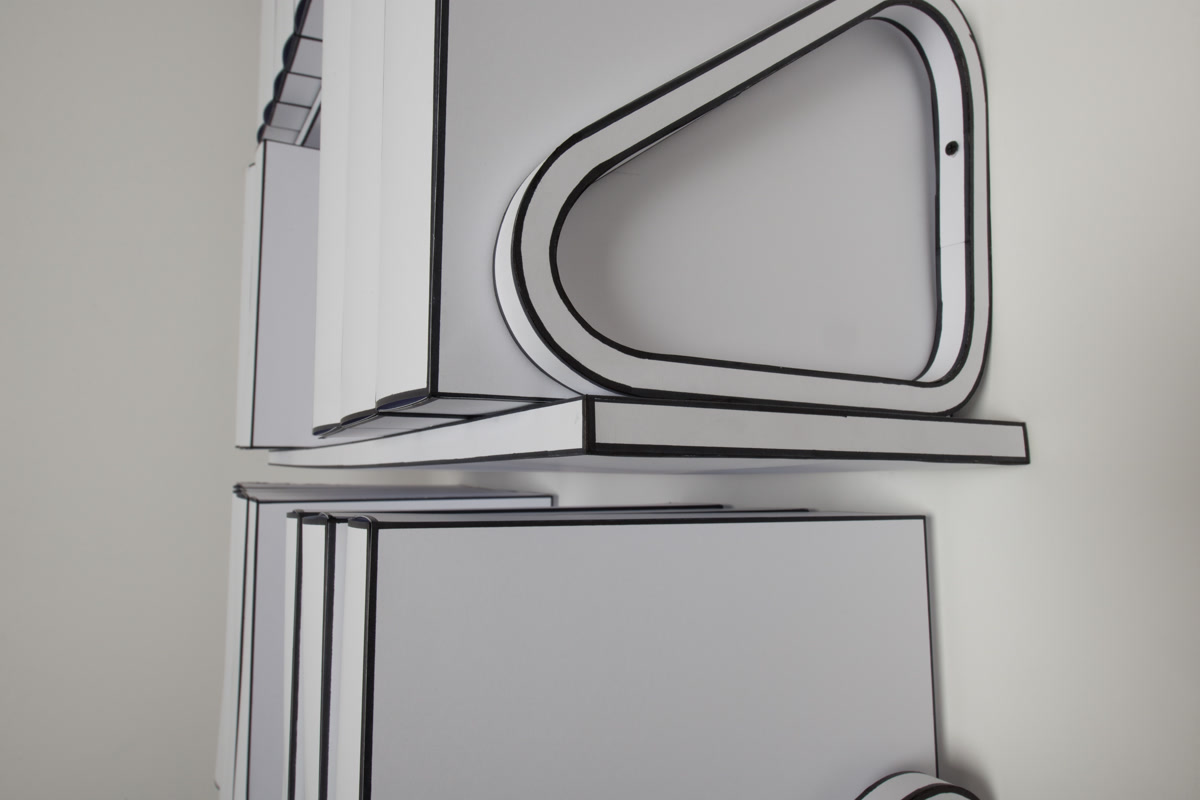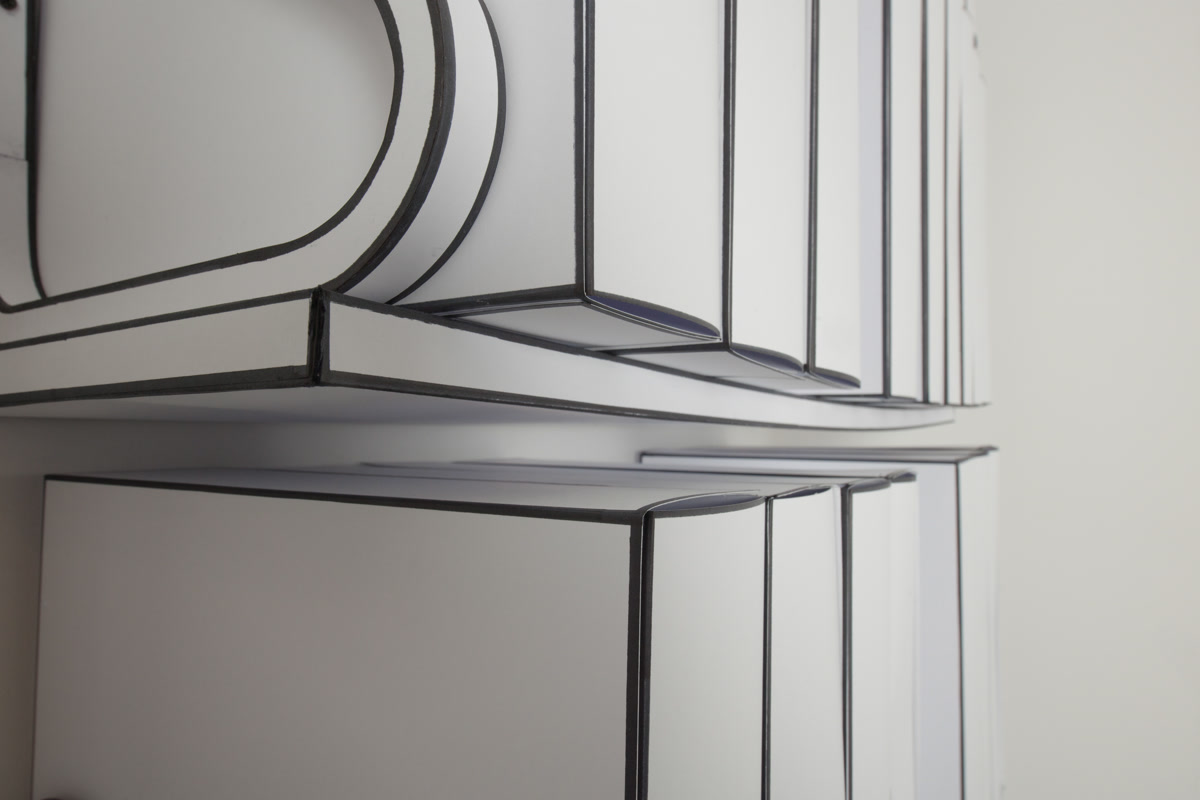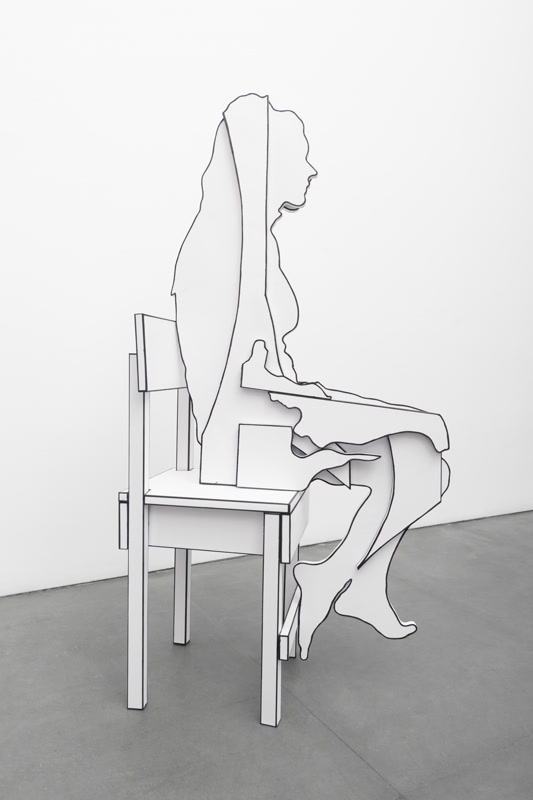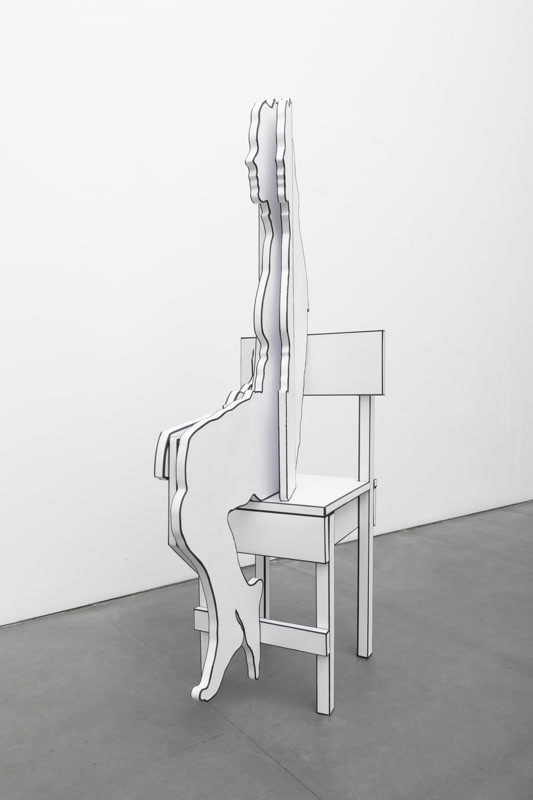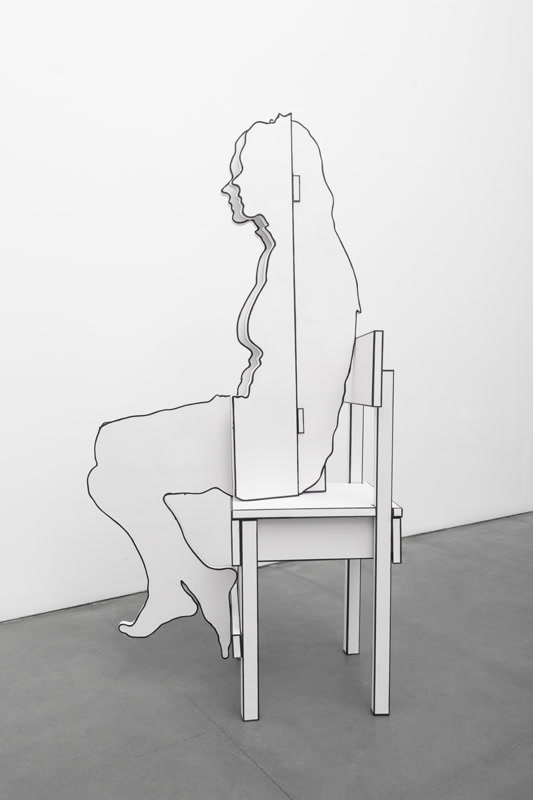Untitled (Reconstruction of Lia Rumma’s Archive), constructed for Lia Rumma in Naples, is characterized by a tension between the representation of the real and its negative inscription. The project consists of two parts: a reconstruction, in white cardboard and actual shelves, of the archival filing system of Lia Rumma’s gallery, and a domestic element, a sculptural object, highly graphic in character, made of the same white material with an incised vectorial drawing, reproducing a Mario Ceroli sculpture of a seated female figure, with the title Portrait of Lia, in the private collection of Lia Rumma. At first glance, the installation reads as a replica of a specific space containing real objects: the library and archive of the gallerist. Further encounters with only complicate the initial impression, making it clear that what we are dealing with is a work that is riven by ambiguity regarding its representational status, issuing a potent challenge to ingrained perceptual codes and aesthetic assumptions.
Although the overall form of the intervention, in its occupation from floor to ceiling of a space flanking the entry to the first of the gallery rooms, suggests an actual archival storage space, it is a meticulously constructed illusion. Low-key, anonymous and neutral, the work initially gives the impression of engaging an aesthetic of pure description, only to disrupt this reading with the realization that no actual archiving can take place here. In this way the installation becomes its own subject, storing itself in a new version of the archive. Due to its neutral givenness and deadpan use of defunctionalization, Mancini’s project signals both a negation and a repositing of the actuality of the real. Enacting a self-sufficient paradox, the content of the space coincides with the container: the technique of archiving as well as its evoked locus corresponds in the most literal sense to the space of memory storage, which is however strangely displaced.
The fact that the vectorial drawing of the replica of the Ceroli figure is one which follows the contours of its own object while flattening it out also participates in this same self-referential logic of the memory trace that builds on its own forms, consuming them and any possible hint of interiority in the process.
It is possible to situate this self-referential idea, and along with it, the art of Mancini in general, within the Conceptualist project inherited from the 60s and 70s, along with specific assumptions about neutrality, system, seriality, and anonymity, qualities constitutive of Conceptualism. Given the explicit link with the gallerist and the function of archiving, it is plausible to see the work as a new inflection of Conceptual Art in the direction of an “oblique portraiture”. In any case, the undecidability of the mimetic role of the installation is the source of its latent, and far from obvious, critical charge, both as an instance of portraiture and as a neutral and neutralizing assemblage. From this perspective, the replication of the gallerist’s living and work spaces and their artistic and bureaucratic contents, playing off the real space of the gallery itself, is at once a highly mediated act of portraiture and something which moves beyond portraiture as a recognizable artistic genre.
Displacing the original, Mancini’s intervention modifies the archive in its interior disposition while meticulously preserving its outward appearance. As such it also bears some similarity to a film set or theater set design, in addition to evoking the idea of a photographic negative transposed into three dimensions. Paraphrasing Roland Barthes, one might describe it as a sort of “installation degree zero”, claiming complete neutrality vis a vis its object of representation, which is ultimately Lia Rumma qua gallerist and archivist of the contemporary artistic experience. It is not identical with, but is in some sense equivalent to its subject.
The Ceroli “reproduction” raises several related questions, none of which are completely resolved by the installation as a whole. There is, of course, a well-established history within modern and contemporary art centering on the reproduction of canonical artworks for critical and parodic purposes or with the aim of opening an internal distance within the artistic project: from Duchamp’s parody of Mona Lisa to Mike Kelley’s and Paul McCarthy’s send-up of Duchamp’s own Étant Donnés modern and contemporary artists have incorporated “recreations” of artworks as an integral part of their logic of invention. The Ceroli reproduction can, in one sense, be placed within this history. Yet it also stands outside of it, since it is “interpellated” into Mancini’s installation due to the simple fact that it is part of Lia Rumma’s collection, and the installation is at one level an oblique and detached “portrait” of the gallerist. This reading of the work is obliged to register the singularity of such a portrait,
since what we are confronted with here is one of the only times in the history of contemporary art that an architectural installation functions as a form of portraiture. To be sure, other motives for this act of critical reappropriation and/or distancing are also in evidence, motives that involve issues of memory and the transmission of cultural ideas across time. In any case, the archival replica alongside the schematically reduced seated figure on the flattened out chair share something in common: both are instances of despatialization. Flatness and space are thus made to speak to one another in a new way, as if to comment on the fading of memory and its revival over time. In this respect Mancini’s act of mnemic revalorization through Conceptual replication creates “spaces within spaces”, “ambienti in ambienti” that evoke a similar telescoping of “times within times”. Ultimately, this spatio-temporal nesting implies a more dynamic vision of the archive than we are usually accustomed to, one that is oriented towards the future, rather than being focused exclusively on the past.
Daniel Sherer
Project exhibited in:
Senza titolo, Lia Rumma Gallery, Naples, 2013
